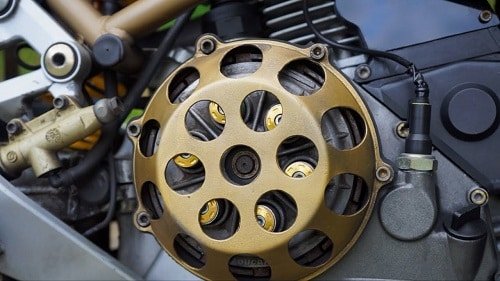If you’ve ever been stopped at a traffic light and heard a clattering sports bike like it was going to explode, then you’re familiar with the iconic sound of a dry clutch.
Most of the bikes on the road have wet clutches, so what’s the difference, and why would a manufacturer or a rider choose one over the other?
What Are The Advantages Of A Wet Clutch?
Table of Contents
To kick things off, let’s talk about wet clutches. They’re referred to as wet because they are bathed in engine oil.
The oils’ primary purpose is to cool the clutch pack because wet clutches can take a lot of abuse because of this cooling effect.
We’re talking about the type of stuff that you might dish out in stop-and-go traffic.
What Is The Benefit of a Wet Clutch?
Wet clutches tend to offer a nice wide engagement threshold that makes them pretty easy to use.
They also last a long time, and they tend to be quite a bit quieter than dry clutches. Also, did I just mentioned they could take a lot of abuse?
That’s a great characteristic, especially if you’re just learning how to ride or just don’t want to replace your clutch every 10000 miles.
On the flip side, wet clutches make your engine oil dirty faster since all the dust created as the clutch wears stays inside the engine.
Thankfully, the oil filter takes care of that. Also, wet clutches are just a little bit Messier to work on.
Advantage of A Dry Clutch

Additionally, because the clutch is spinning in oil, there’s a little bit of fluid drag that saps some of the engine’s power.
Avoiding that fluid drag is the number one benefit of a dry clutch. Dry clutches, as you might have guessed already, are not bathed in oil. They are sealed off from the rest of the crankcase.
The Disadvantage of A Dry Clutch
That means less fluid drag and more horsepower going to the rear wheel, as well as cleaner oil.
But it also means less cooling for the clutch pack. Without oil to cool things and damp engagement. Dry clutches will act up if you hammer them, plus they tend to be a little bit grabby and more difficult to modulate.
Dry clutches also don’t last that long, and they are a lot noisier, especially if you run an open clutch cover like a lot of guys do to help keep the clutch pack cool.
Dry clutches are easier to work on since you don’t have to deal with any oil, plus they look and sound awesome.
If you were to listen to a Ducati dry clutch, you would hear the legendary tambourine like the rattle of a Ducati dry clutch.
I think it sounds fantastic, but it’s because of all that noise that the dry clutch has pretty much gone extinct.
As noise regulations get stricter and stricter, every decibel counts, and switching to a quieter wet clutch means there’s more noise in the budget for other things, like a sweeter sounding exhaust.
Two places you are still going to see dry clutches or a Moto Guzzi, and in moto GP.
Moto Guzzi still uses dry clutches because they’re pretty much stuck in the stone age. You see them in MotoGP because in racing, every little advantage counts, and as I pointed out before, a dry clutch puts less drag on the engine.
Recent Posts
- 4 Things To Wear To Stay Warm On Your Motorcycle In Winter
 Most of us here ride to work every day all year round, and we have lots of personal experience when it comes to taming the elements.
Most of us here ride to work every day all year round, and we have lots of personal experience when it comes to taming the elements. - How To Clean Your Motorcycle In 5 Easy Steps
 We all love a clean and shiny motorcycle but knowing which cleaning products to buy can sometimes be a little daunting, and so too can be the method to clean your motorcycle.
We all love a clean and shiny motorcycle but knowing which cleaning products to buy can sometimes be a little daunting, and so too can be the method to clean your motorcycle. - How Does A Manual Transmission Work On A Motorcycle
 For most people, their motorcycle transmission is one of the most mysterious parts of their bike. How does it work, and why do we shift down into first, but then
For most people, their motorcycle transmission is one of the most mysterious parts of their bike. How does it work, and why do we shift down into first, but then - How Sprockets Affect Speed on Motorcycles And Why
 It doesn’t matter if you’re a racer; if you’re just into trails riding your dual-sport, your bike can be geared differently to your performance needs. Not only on a dirt
It doesn’t matter if you’re a racer; if you’re just into trails riding your dual-sport, your bike can be geared differently to your performance needs. Not only on a dirt - 3 Reasons Why Wheelies Are Bad For Your Motorcycle
 Wheelies are super fun, and we all know that wheelies are one of the purest forms of joy known to humanity, but they can be dangerous. Wheelies are bad for
Wheelies are super fun, and we all know that wheelies are one of the purest forms of joy known to humanity, but they can be dangerous. Wheelies are bad for


